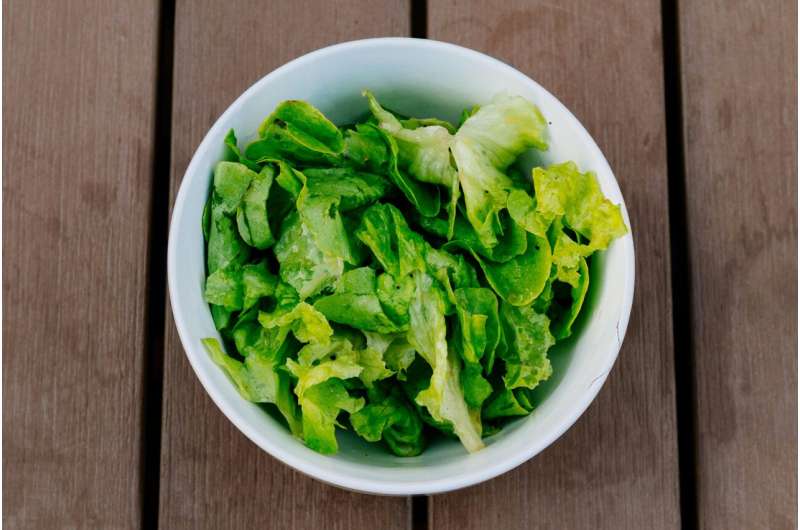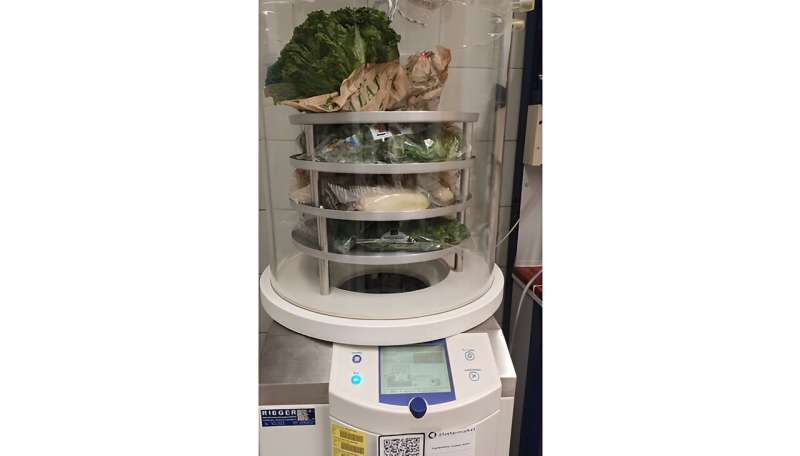This article has been reviewed according to Science X's editorial process and policies. Editors have highlighted the following attributes while ensuring the content's credibility:
fact-checked
trusted source
proofread
Irrigation with treated wastewater and sewage sludge introduces tire additives into leafy vegetables, study finds

The presence of drug residues in commercially sold fruit and vegetables has already been scientifically investigated many times. However, chemical substances from tire wear, so-called additives, also find their way into the food chain.
This has now been shown in a new study published in Frontiers in Environmental Science by an international research team led by Thilo Hofmann at the Center for Microbiology and Environmental Systems Science at the University of Vienna (CeMESS) in collaboration with a team the Hebrew University of Jerusalem led by Benny Chefetz.
Vegetables from Switzerland and Israel were examined. Some of these substances and their transformation products can potentially pose ecological and toxicological risks.
Car tires consist of a complex mixture of materials that improve their performance and durability. These include 5%–15% chemical additives, which comprise hundreds of substances, for example antioxidants, antiozonants, vulcanizing agents, anti-aging agents and many more, to enable the high-tech performance of a modern tire.
"The toxicity of tire and road wear particles is related to their organic additives and associated transformation products," explains Anya Sherman, Ph.D. student at CeMESS and first author of the recently published study.
The compounds extracted from car tires find their way into agriculture through atmospheric deposition, irrigation with treated wastewater and the use of sewage sludge as fertilizer. "There they can be taken-up by plants and thus also reach humans," adds Thilo Hofmann, head of the research group.
Residues of tire wear in leafy vegetables from the supermarket and field
The researchers extrapolated the measured values from the vegetables to the intake of these substances in the diet. "We calculated the intake per day based on what people in Switzerland and Israel eat," says Sherman.
The concentrations of the tire additives in leafy vegetables are low overall and are, for example, 238 nanograms ng/kg for benzothiazole (BTZ), or 0.4 ng/kg for 6PPD, a substance whose transformation product 6PPD quinone is known to be highly toxic for aquatic species like coho salmon. Depending on the diet, this leads to a daily intake per person of 12 to 1,296 ng for BTZ, or 0.06 to 2.6 ng for 6PPD.
This is comparable in magnitude to drug residues, which also enter the food chain. According to Thilo Hofmann, the study shows clear results: "While the concentrations and daily intake are fortunately relatively low, additives from car tires are still found in food. That's not where they belong."
According to Hofmann, the next steps should now be to investigate the environmental and human health aspects.

From the street, to the plant, into the body
As early as 2023, the scientists were able to show that additives from car tires can in principle be absorbed by plants. "However, the question was whether this only happens in our mechanistic laboratory study or also in the field," explains first author Anya Sherman.
In the current study, the Viennese and Israeli environmental scientists therefore analyzed whether lettuce plants absorb the chemicals released by car tires under natural growing conditions. "We examined real samples from supermarkets in Switzerland and field vegetables from Israel," says Thilo Hofmann.
The international team of researchers used high-resolution mass spectrometry to analyze the samples for a total of 16 tire-associated compounds. The countries of origin of the leafy vegetables in the Swiss samples from the supermarket were Italy, Spain, and Switzerland. In the Israeli samples, field vegetables from Israel directly after harvest.
More information: Anya Sherman et al, Uptake of tire-derived compounds in leafy vegetables and implications for human dietary exposure, Frontiers in Environmental Science (2024). DOI: 10.3389/fenvs.2024.1384506
Provided by University of Vienna





















